| Columns Retired Columns & Blogs |
Even uses a Burr-Brown chip. Way better with more functionality, and the price obviously reflects that.
I measured the first sample of the WiiM Mini with my Audio Precision SYS2722 system, repeating some tests with the second sample. Looking first at the WiiM's analog inputs and outputs, the input impedance was a usefully high 32k ohms at 20Hz and 1kHz, 13k ohms at 20kHz. The analog output preserved absolute polarity (ie, it was noninverting), and the source impedance was a low 33 ohms from 20Hz to 20kHz. The gain was 0.37dB with the fixed gain set to "1V." With the fixed gain set to "2V (Loud)," the gain was 5.8dB at the outputs; that is, an input of 1V resulted in an output of 1.955V.
The analog input offered a frequency response that rolled off rapidly above 21kHz (fig.1), which is due to analog input signals being digitized at a sample rate of 48kHz. The right-channel response (red trace) had a +0.2dB plateau below 2kHz and at the top of the audioband. Channel separation (not shown) was excellent, at >110dB below 1kHz and still 90dB at the top of the audioband. The low-frequency noisefloor (fig.2) was free from power supply–related spuriae, but low-level components of unknown origin were present at 36Hz, 72Hz, and 964Hz.
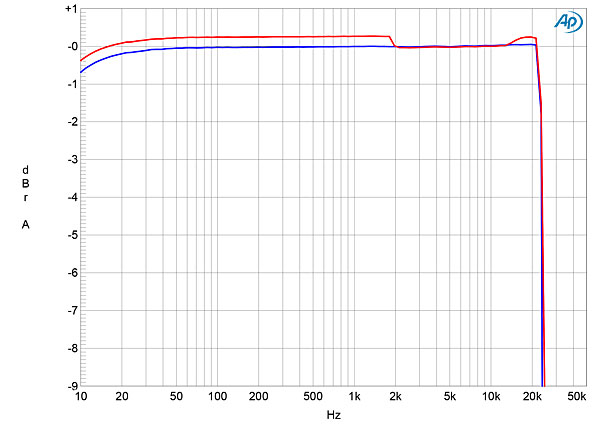
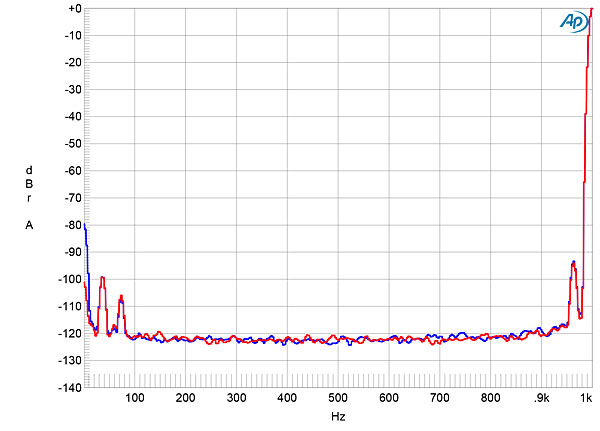
Fig.3 plots the percentage of THD+noise in the Mini's output against the output voltage into 100k ohms. The fixed gain was set to "2V" for this measurement. We specify clipping voltage as when the THD+N reaches 1%, and the 1% point is reached just above 2V. When repeating this test with the fixed gain set to "1V," the THD+N reached 1% at 1.1V (not shown). Both clipping points occurred when the input level was 1.05V. The distortion in fig.3 lay below the noisefloor, below 1V, and with a 50Hz signal at 2V into 100k ohms (fig.4), the second and third harmonics were the highest in level, at a still very low –87dB and –83dB, respectively. Repeating this test with a 600 ohm load (not shown) both increased the levels of the second and third harmonics and introduced higher-order harmonics in the right channel but not the left. Similarly, the right channel had higher levels of intermodulation products (fig.5, red trace) than the left (blue) when driven with an equal mix of 19 and 20kHz tones at a peak level of 2V into 100k ohms. The higher levels of the products at 28kHz and 29kHz confirm that the analog input is digitized at 48kHz. (Their frequencies are equal to 48–20kHz and 48–19kHz, respectively.)
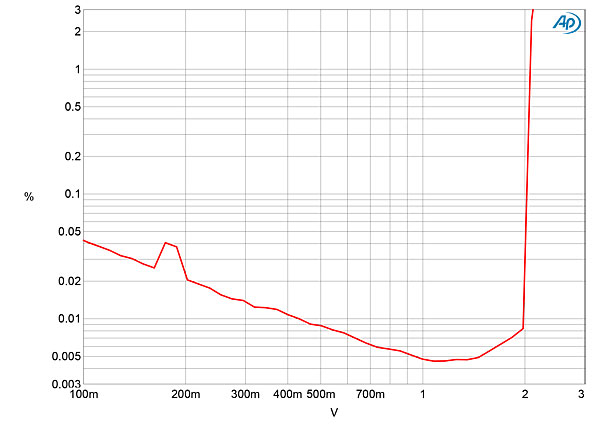
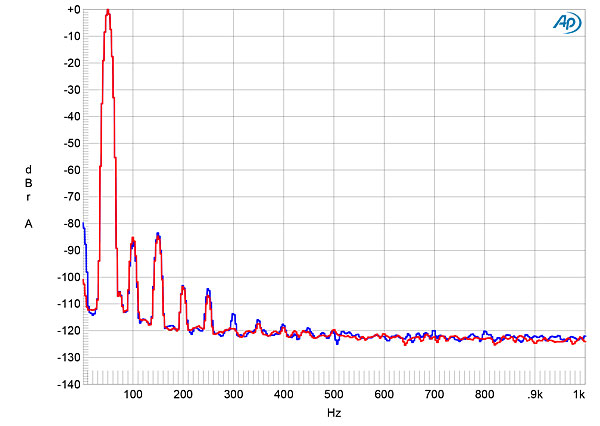
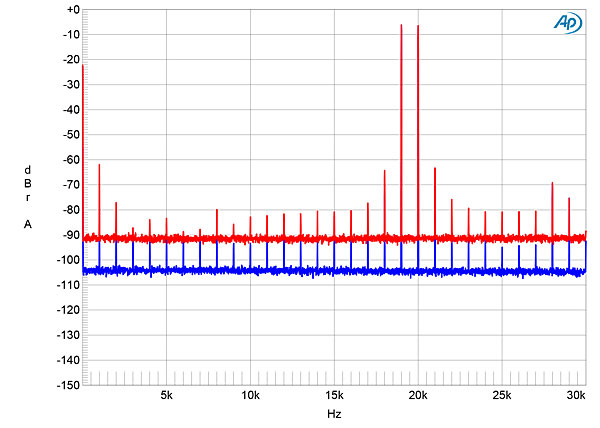
Turning to files stored on my iPad mini 2 and transmitted to the WiiM Mini via Wi-Fi (using the WiiM Home app), the Mini accepted data sampled at rates up to 96kHz. Fig.6 shows the WiiM's frequency response with data sampled at 44.1 and 96kHz. The responses are flat almost to half the sample rate, before quickly rolling off. The output level at the analog output was 1V or 1.985V, depending on the fixed output level setting, and preserved absolute polarity.
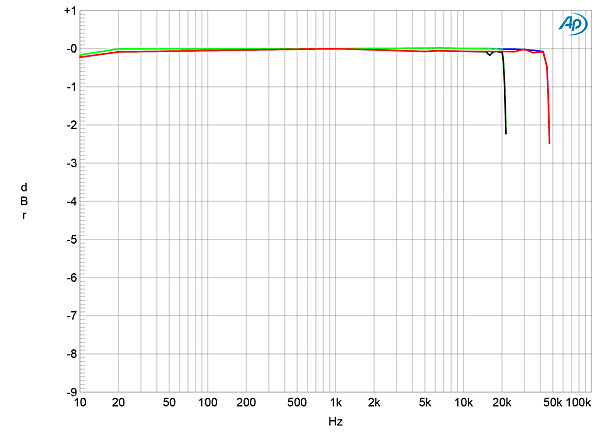
The Mini's impulse response with 44.1kHz data (fig.7) is typical of a linear-phase reconstruction filter, with equal amounts of ringing on both sides of the single full-scale sample. With 24-bit/44.1kHz white-noise data, the filter rolled off rapidly above the audioband (fig.8, magenta and red traces), reaching full stop-band attenuation at 24kHz. However, the ultrasonic noisefloor has an odd, scalloped appearance. The aliased image at 25kHz of a full-scale tone at 19.1kHz (cyan, blue) is only suppressed by 60dB, but more significantly, the noisefloor with this signal is relatively high in level. The harmonics associated with the 19.1kHz tone all lie at around –60dB but have sidebands present at ±1100Hz, as does the fundamental.
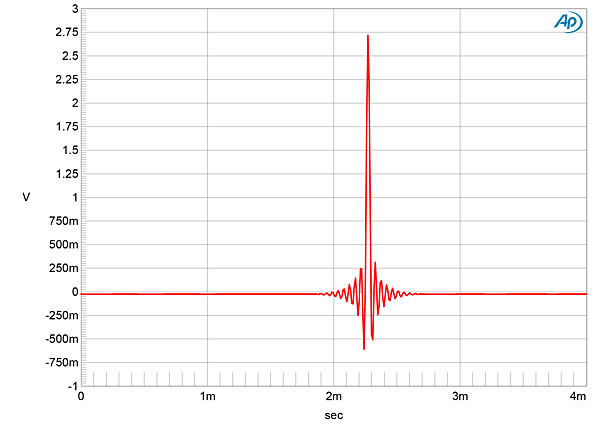
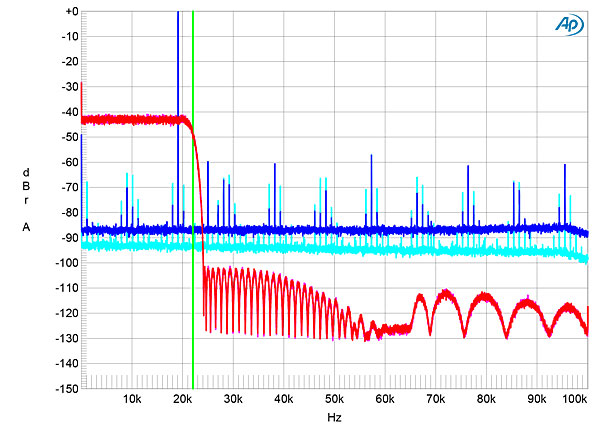
Though an increase in bit depth from 16 to 24 with dithered data representing a 1kHz tone at –90dBFS (fig.9) lowered the level of random noise by almost 30dB—the noisefloor with 16-bit data (cyan and magenta traces) is due to the dither used to encode the signal—the 1kHz signal has disappeared with 24-bit data (blue, red). This confirms that the DAC resolution is limited to 16 bits, as described in the specifications. When I played a full-scale 1kHz tone, the second harmonic was the highest in level in the analog output, at just –90dB (0.003%, fig.10).
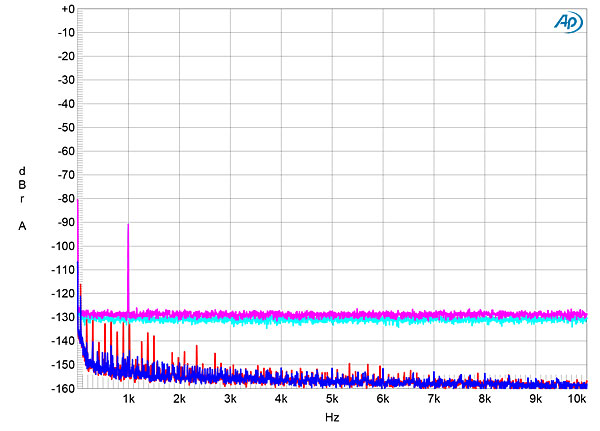
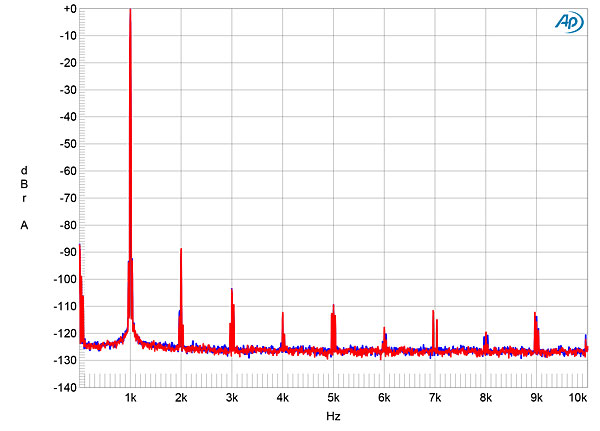
Fig.11 shows the spectrum of the Mini's analog output when it was fed 16-bit J-Test data from my iPhone 11 with the WiiM Home app. The odd-order harmonics of the undithered low-frequency, LSB-level squarewave lie close to the correct levels, indicated by the sloping green line. The central peak that represents the high-level tone at one-quarter the sample rate has some spreading visible at its base, implying the existence of low-frequency random jitter.
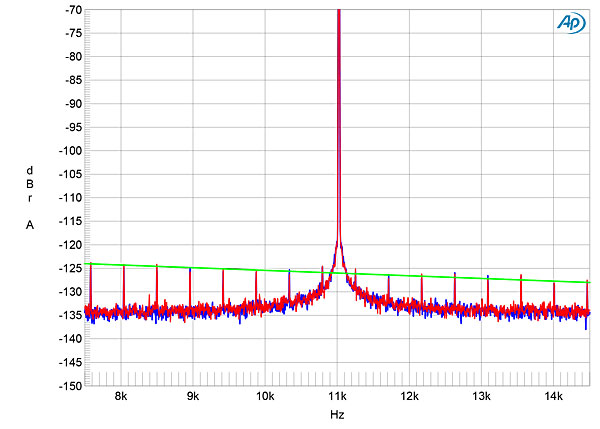
The WiiM Mini's TosLink output was bit-accurate. I examined the amount of timing uncertainty—jitter—in the TosLink output using my Audio Precision SYS2722 system's digital oscilloscope function. I overlaid successive snapshots of the Mini's digital output, taken over a 60s time window, to show what's called an "eye pattern." All the pulse transitions in the datastream should overlay one another to produce an image of a wide-open "eye," with just one trace visible. This was the case with the Mini (fig.12) with the original 44.1kHz data plotted over one "unit cycle." The eye is wide open, with no blurring of the leading and trailing edges. The average jitter level, assessed with a 50Hz–100kHz bandwidth, was a relatively low 729.7 picoseconds, though with typical music recordings it averaged 1.6 nanoseconds.
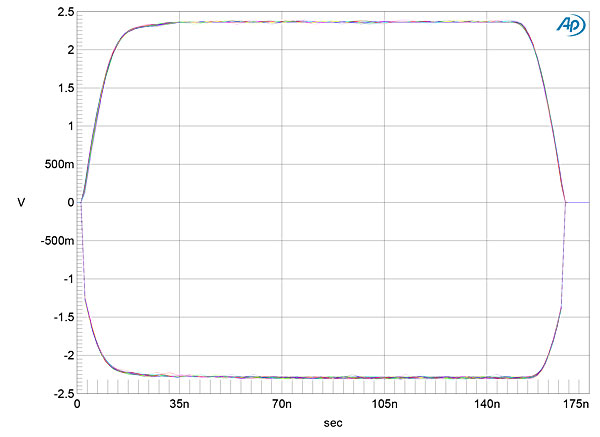
I was pleasantly surprised by the measured performance of the WiiM Mini's analog input and output. My experience of other extremely low-priced D/A processors had lowered my expectations, and while the analog output is limited to 16 bits, the only significant issue I found was the higher distortion at high frequencies and into low impedances.—John Atkinson

Even uses a Burr-Brown chip. Way better with more functionality, and the price obviously reflects that.

For those that use Tidal, you may appreciate the "Tidal Connect" feature that allows you to use the native Tidal app to control the streamer. Use the Wiim app to set things up initially, then use the native Tidal app thereafter. Easily the best way to control the streamer, IMO. I see there is a Spotify Connect as well so assume that works the same way for Spotify users (though I don't believe Spotify has yet offered CD quality tier to its users).
FWIW, I think it may be possible to play local files via the Wiim as well, but I've not looked into that. Also, it seems the Wiim cannot output on its analog and digital outputs simultaneously as I could not get a lock on my DAC if I was also feeding another system via the analog out. Minor issue but something to be aware of. I assume I'm getting 16/44 which is all I subscribe to so I don think there's any truncating issues for me to be concerned about, but I'll update the software anyway.
I'd been tempted many a time to do a RPi build, but was lazy about it. Turns out this is what I really wanted - it just didn't exist until recently. Love mine!
EDIT: The Wiim does have Bluetooth input, which could be handy for some YouTube or Pandora transmission to the Wiim since these are not high fidelity streams anyway. Also, I went back to the Wiim Home App and was able to find my shared computer that houses some ripped files so I think I'm close to being able to play locally stored files on the Wiim.

Can this device access files on my WiFi-connected Windows PC without needing a network bridge or other hardware?

This looks like it could be exactly the solution I’ve been looking for! Inexpensive enough to try it and even if it doesn’t do everything I hope it does keep it because it seems that it will do plenty!

Agreed no ethernet. The is not just the cheapest category thing. I use a re-clock dejiter SPDIF device between the WIM Mini and my processor. But many people might benefit from a USB audio output. In addition the Pro version should aspire to do Amazon Music Atmos and Ultra HD.
I am lost why anyone would use Tidal or Qobuz. If you have Amazon Prime just stick to the Amazon Music Ultra HD tracks.
Why are audiophiles making this complicated? It is going to come down to Apple Music vs. Amazon Music and the bundles people want.

John, now that the newer WiiM Pro is available for sale (currently $149 with free shipping from a large online retail vendor), it may be worthwhile to review that one too.

First off, I'm a 2 channel stereophile having zero glossary savvy for the streaming nomenclature, or should I say, streamingculture. A music source like a CD is normally corded to a preamp or integrated amp and then speakerwires out to speakers,that is status quo for me now. Wanting to "grow up", I seek to stream. In comes a WiiM Mini!
Options, I understand are Optic cables, being digital and my home having a WiFi signal from my router fed by a fiberoptic cable I subscribe to. My internet has about a 3 gig signal. My router has a Cat5 output/passthru, but is not where I can easily use a cable. So, WiFi it is. Now, I guess I use my Amazon Atmos music HD songs, that I get thru my laptop? and the laptop uses a signal to the WiiM mini? or the WiiM mini automatically links to the WiFi?
Help me ObiWan Kenobe, your my only hope!
As it is I have an Anthem Preamp having a Optilink digital input. Do I put a cable from the WiiM output to the Preamp input and the WiiM gets the musical signal from the WiFi? How do I manage this in a GUI way? does my laptop screen have an app that shows music libarary and I select from there and it plays music? or Does the Wizard Of Oz require I know the rest of the vernacular?
There are many terms used in descriptions of streaming music that are forign and assumed understanding. I do understand I seek lossles signal, (FLAC). I do recognize I must subscribe to a streaming music service or use my Amazon prime streaming content. The hardware is the WiiM Mini connected to a powersupply using the USB C cord for powering it. Then to optional optical cable to the Preamp. Is that all I need?